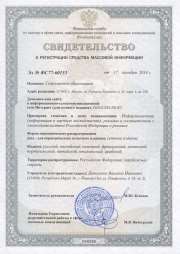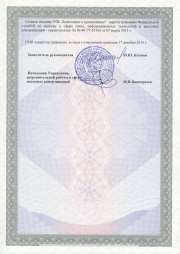MAIN PAGE
> Back to contents
Modern Education
Reference:
Menzhulina D.
Language Trainers as a Means of Electronic Linguodidactics: Experience in the Development and Implementation of the Video Tutorial Cycle "A Walk in the Primorsky Territory" in the RCT Learning Process
// Modern Education.
2023. є 2.
P. 34-43.
DOI: 10.7256/2454-0676.2023.1.37584.2 EDN: RKOKAY URL: https://en.nbpublish.com/library_read_article.php?id=69834
Language Trainers as a Means of Electronic Linguodidactics: Experience in the Development and Implementation of the Video Tutorial Cycle "A Walk in the Primorsky Territory" in the RCT Learning Process
Menzhulina Dar'ya
ORCID: 0000-0003-2147-2886
Assistant, Department of Russian as a Foreign Language, Far Eastern Federal University
690922, Russia, Primorsky Krai, Vladivostok, Ajax str., 10, office D524

|
koffikor@yandex.ru
|
|
 |
Other publications by this author
|
|
|
DOI: 10.7256/2454-0676.2023.1.37584.2
EDN: RKOKAY
Received:
27-02-2022
Published:
27-02-2024
Abstract:
The subject of this study is the linguodidactic and linguometodic potential of an interactive simulator as a means of electronic linguodidactics in teaching Russian as a foreign language. During the research, a set of methods is used: methodological modeling, questionnaires, expert evaluation, etc. The primary method of research is a pedagogical experiment. During the experiment, a model of the educational process was built using a language trainer as a means of electronic linguodidactics. The pedagogical experiment was conducted in three stages and was aimed at studying the features of the educational process when teaching Russian as a foreign language using electronic linguodidactics. The data for the analysis were collected by questioning the students who participated in the experiment. The relevance of the study of electronic linguodidactics in teaching RCT lies in the fact that during the pandemic and with a mass transition to distance learning, the needs of students in intensive foreign language acquisition courses continue to grow. RCT teachers must create and use electronic educational resources in language teaching and their multidisciplinary development. In addition, the idea of syncretism in educational technologies seems relevant. The study made it possible to formulate the theoretical foundations of the linguometodic simulator and to confirm its practical significance in teaching RCT. The theoretical and practical significance of the research lies in deepening and expanding scientific and methodological ideas about the place and role of an interactive language trainer in the environment of electronic means of teaching RCT, as well as in presenting opportunities to improve the effectiveness of the formation of language skills and speech skills in teaching RCT. The main conclusion of this study is the position on the relevance of the use of electronic linguodidactics in the teaching of RCT, in particular, an interactive language trainer.
Keywords:
Russian language, methods of teaching, language trainer, interactive teaching, language teaching, multimedia, linguodidactics, e-learning, electronic resources, modern technologies
Previously published in Russian in the journal Pedagogy and Education https://nbpublish.com/ppmag/
Introduction
Society's actively developing need for intensive mastery of foreign languages has led to the rapid development of technologies in teaching foreign languages. This prompts us to take a fresh look at how electronic linguodidactics can organize the educational process.
According to D. A. Gartsov, the need to use electronic technologies in the educational process is dictated by the peculiarities of the psychology of perception and assimilation of new information of modern students who prefer working with electronic learning tools and want to receive information in a concise, accessible form [1, p. 26].
Computer programs organize the educational process more effectively by providing information in a more structured form that more easily holds students’ attention due to the effects of animation, video texts, diagrams, graphs, drawings, and other means of visualization. Electronic linguodidactics make it possible to explain educational material more clearly and accessible in accordance with students' psychological characteristics [2].
According to I. A. Gonchar and T. I. Popova, "The educational potential of EOR is provided by the implementation of basic general methodological principles in it, such as the principle of oral advance, the principle of interconnected learning for all types of speech activity, the principle of complicating educational tasks from simpler to more complex, the principle of concentricity" [3, p. 84].
I. V. Voronina believes that electronic educational resources allow users to communicate "in real-time with a remote subject, prompt provision of information, ongoing monitoring of the state of the process" [4, p. 9].
Thus, the use of EOR in teaching a foreign language has a positive effect on the psychological climate of the group of students, creates an opportunity for the implementation of individualization of learning, and activates the skill of independent work. With the help of electronic learning tools, it is possible to implement feedback and combine control and self-control when students perform and check tasks. All this makes the educational process more efficient and increases students’ motivation and interest [5].
To ensure the effectiveness of the educational process, teachers need to know how certain resources function and be able to develop their own educational technologies using electronic linguodidactics.
It is impossible to create a universal educational resource because when developing an educational resource, first of all, it is necessary to consider students' individual characteristics, including age, language, and social characteristics. Electronic linguodidactics in teaching (interactive, multi-media programs, textbooks) does not deny the existence of printed learning tools. In their study, E. A. Vereshchagina and T. A. Zhukova say that the formation of effective didactic learning strategies using electronic linguodidactics is based on strategies related to the traditional educational process [6].
Russian language teaching using electronic linguodidactics will lead to "a qualitative leap in the creation of innovative didactic and methodological means of teaching foreign (Russian) languages," according to A.D. Gartsov. "Languages due to the high adaptability, target and functional orientation of educational materials, their variability, flexibility, etc." [7].
The language trainer is one of the means of electronic linguodidactics. The classification of computer technologies for teaching RCT by G.M. Starygina and A. O. Andreichenko refers to control and training applications primarily intended to prepare international students for the certification exam in the Russian language in the form of tests [8].
A language trainer is understood as a means of teaching a foreign language in the form of a specialized multimedia distance learning program aimed at consolidating a linguistic skill by repeated repetition. The linguistic simulator combines the properties of traditional exercises and tables. A characteristic feature of simulators is the presence of training tasks and keys, which provide quick feedback with the possibility of evaluation and self-assessment [8, p. 111; 9, p. 217]. Training tasks differ from traditional exercises by an organized system consisting of the following elements: training goals and objectives; content (concepts and rules that can be presented in the form of tables); diagnostic and control systems (test exercises, keys to them, means for self-assessment of students based on the results of completed tasks). [10, p. 193–198]
Based on the platform Islcollective.com, a cycle of language exercises, "Walking in Vladivostok," was developed and tested.
The cycle of video tutorials "Walking around Vladivostok" includes the following topics (locations):
1. Railway station
(https://en.islcollective.com/video-lessons/show/zheleznodorozhnyj-vokzal-vladivostok/431036)
2. Oceanarium
(https://ru.islcollective.com/video-lessons/show/okeanarium-vladivostok/431895)
3. Airport
(https://en.islcollective.com/video-lessons/show/aeroport-gvladivostok/475789)
4. Funicular
(https://en.islcollective.com/video-lessons/show/funikulyor-g-vladivostok/475797)
5. Golden Bridge
(https://en.islcollective.com/video-lessons/show/untitled-lesson/475805)
The proposed means of electronic linguodidactics is an electronic educational resource. This is not an electronic textbook because it is not a simple analog of a paper textbook; it does not have the structural organization of a textbook. The electronic educational resource includes video clips with different tasks that students can perform on a computer or tablet.
The word "resource" comes from the French ressource ("auxiliary tool"). This fully reflects the functional significance of an electronic educational resource: it can be considered an additional educational tool that promotes the activation of students' speech skills and increases the motivation to learn Russian in a specific language environment.
In this study, an educational and methodological set of tasks aimed at developing listening skills in the format of an interactive language trainer on the platform has been designed and experimentally tested by Islcollective.com. The language trainer is a series of video tutorials, "Walking around Vladivostok." The educational and methodological complex of tasks is based on the material of authentic video fragments from video reports, TV shows, etc.
The proposed linguistic exercises aim to develop listening skills, practical speech skills of understanding the meaning of a single utterance, memorizing speech material, and highlighting the main thing in the flow of information in implementing communicative activities. A number of tasks related to the development of auditory memory and speech response are implemented in linguometodic simulators.
Student learning is motivated by the interactivity of the educational process. The teaching materials are based on the following general methodological principles:
1. addressability
2. structuring
3. control/verification of knowledge
4. the principle of complication of speech genres and types of texts
5. The principle of multilevel (various video materials for levels A2 and B1 are presented).
1. Addressability
The video tutorial series "Walk in Vladivostok" addresses foreign students of different fields of study who are already studying Russian at the Far Eastern Federal University or are just planning to come study at a Russian university.
This didactic resource can be used as a guide to Vladivostok as the proposed materials reflect reality, give students an idea of where they are coming to study, and suggest what is worth visiting in the city of Vladivostok. Students can watch the video clip without completing the tasks suggested in the video. This will allow students to become more familiar with the surrounding urban environment. As students study, they can refer to this resource more as an educational one by performing tests and exercises.
2. Structuring
Each video tutorial has a universal structure corresponding to the goals of the cycle. Its main feature is the possibility of using the language trainer both in the classroom and remotely as homework, independently, or in an online lesson with a teacher. Let's consider the features of interaction between a student and a resource, a student and a teacher when a video tutorial is used remotely:
1) live and direct classroom contact with the teacher is excluded (when working with the language trainer in question, students' communication with the teacher may be one-sided in the form of instructions, that is, short written and oral messages preceding the start of work, or in the form of comments on sample responses);
2) each section allows students to work at their own pace, reviewing the video as many times as necessary, regardless of the classroom time and the success of individual students;
3) feedback is carried out using a set of automated regulators: correct answers are instantly displayed, which are evaluated on a scale of "true/not true";
This course construction corresponds to the most important principle of teaching foreign languages: the principle of oral advancement, which emphasizes the importance of video as a source of authentic language material. At the same time, we do not mean video recordings of lectures but video clips reflecting various speech situations.
3. Control/verification of knowledge
The control and verification of knowledge in the language exercise "Walk in Vladivostok" is carried out in the following ways:
While watching the video, the student is asked to complete various types of tasks. Some tasks aim to activate the knowledge of grammar, and other tasks activate the understanding of the text. The control is carried out automatically. If the answer is correct, the student sees a form in which the answer is written in green; if the answer is incorrect, the answer form is colored yellow or red. Before completing the task and after, the student can listen to the passage with only the necessary information again by clicking the round arrow on the left (see Fig. 1). Fig. 1. Example of incorrect task execution.
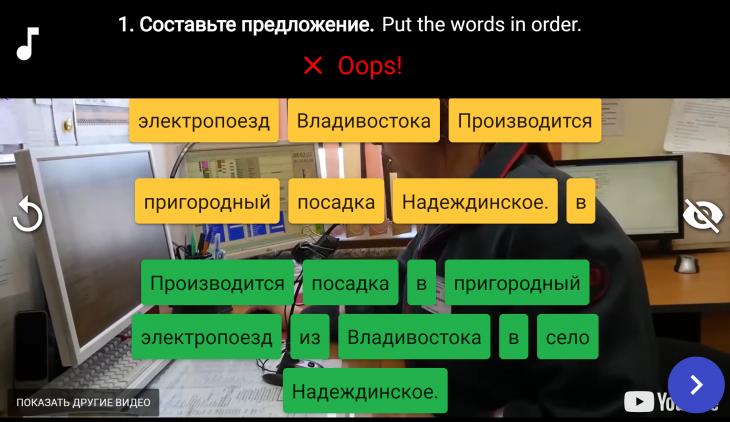
The student can see the number of correct answers in the upper right corner.
As the tasks are completed, the number of correct answers possible is displayed at the top. (see Fig. 2).
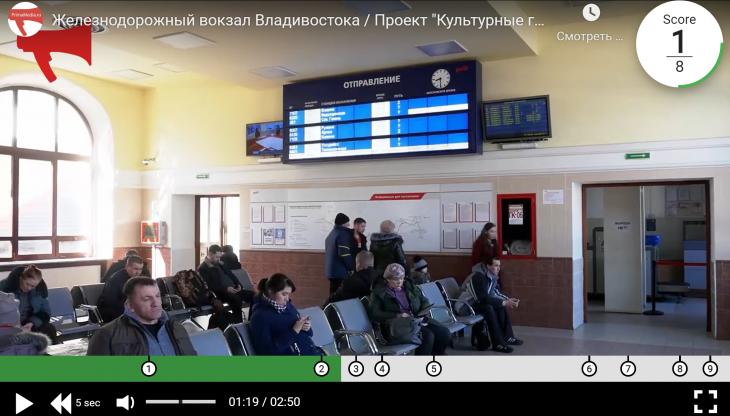
Fig. 2. An example of displaying the number of correct answers.
The language trainer has an element of self-examination in some tasks when the student is asked to independently compare his answer with the proposed one and evaluate it as correct or incorrect (see Figure 3); the teacher can view the student's answers after they complete the video tutorial in full, and write a comment (see Figure 4). Fig. 3. Example of a task with a self-check element.
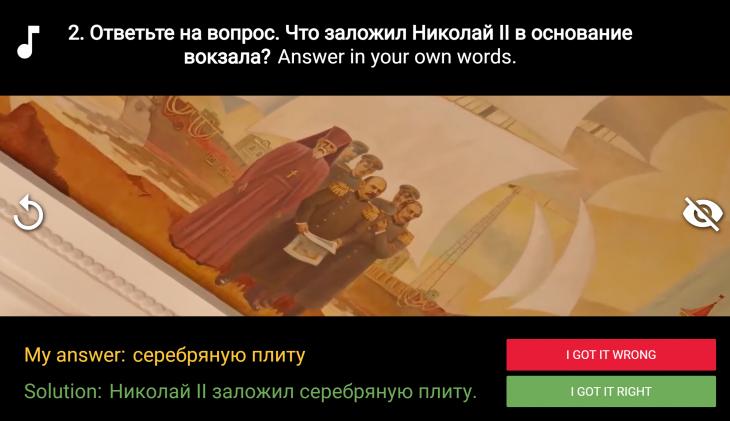
Fig. 4. An example of displaying student responses with the ability to write a comment.
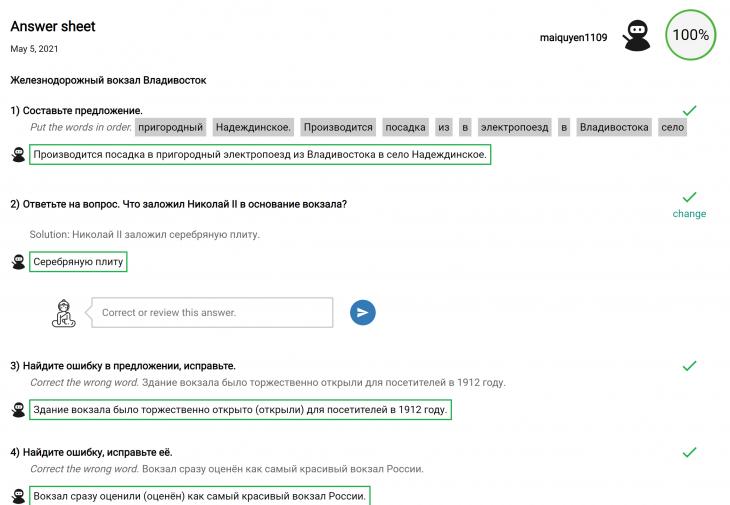
All the linguistic material for the tasks is taken from the video fragment offered to the student.
If the student has difficulty understanding the text, they can use the dictionary the video tutorial provides and then return to the tasks.
4. The principle of complication of speech genres and types of texts
In the series of video tutorials "A Walk in Vladivostok," audio-visual material of various levels is presented as educational material. In the video tutorial cycle, we use only authentic video clips of video reports, TV shows, etc.
5. The principle of multilevels
The video tutorial cycle will contain video material for levels A2–B1.
The principle of multilevel is that this cycle of video tutorials is not a standard textbook or a simple analog of a paper textbook. Each video tutorial can be used separately for a different audience, a whole lesson can be built around it, or it can be set as a homework assignment for working out a specific topic. Students at a weaker level can rely on a subscript and first work out the material on a written text with a teacher; students at a higher level, B1, can immediately work with the simulator independently.
Thus, the simulator implies different types of work for various levels.
A series of video tutorials will be aimed at developing the following skills:
· Listening: understanding the content of journalistic texts presented in an audio recording (based on the material of video clips).
· Reading: the ability to read texts and extract the necessary information. Correlate spoken-sounding text with written text.
· Writing: the ability to answer detailed questions and compose texts on a given topic.
The language trainer within the framework of the video tutorial cycle "Walking around Vladivostok" is an Internet resource that has certain advantages and disadvantages:
Advantages:
1) cross-platform - the ability to work from different devices, which is very convenient for students, especially as most of them have their own electronic devices (phones, tablets, etc.);
2) no need to install the app;
3) no need to download updates.
Disadvantages:
1) the need for an Internet connection;
2) lack of access to the device’s built-in functions;
3) the lack of built-in tools for developing speaking skills and the need to resort to third-party resources.
Research results
Experimental work within the study's framework was organized and carried out at the Far Eastern Federal University using the Microsoft Teams platform from May to June 2021.
The testing of the language trainer took place in three stages:
The first stage: Linguistics students of different groups with a level of proficiency in Russian from A2 to B1 were given a language exercise as homework. The students' results were evaluated using built-in evaluation mechanisms. Feedback was received through a questionnaire students completed after working on a language simulator. Students coped well with the tasks on their own; interaction with the teacher was minimal as they received instructions for completing the task on the simulator.
The second stage: first-year undergraduates studying in the direction of "Russian as a foreign language" performed the tasks of the language trainer together with the teacher, receiving assistance in the educational process. At the end of the lesson, as a homework assignment, students recorded a podcast in which they answered the last question of the simulator, which required the most detailed answer. Thus, it was planned to compensate for the lack of a simulator—the lack of access to speaking.
The third stage: A traditional lesson was developed and experimentally tested with the inclusion of a language trainer as one of the tasks for international students studying international relations. The lesson topic coincided with the topic of the language exercise; grammatical material was selected for the lesson, which was worked out in the language exercise.
A questionnaire was conducted to track the results of testing among students.
According to the results of the survey, the following was found:
The students noted that memorizing new vocabulary and grammatical constructions is easier and more interesting while working with an electronic educational resource and would like more such tasks. All students noted the video format of the lesson as the most effective when working with listening; most would like to learn more about Vladivostok in this format of classes.
The language trainer was equally well received by students as a homework assignment for self-study and an element of a traditional classroom lesson. Using a language trainer in the classroom activated students' attention and aroused interest. Students were happy to get involved in the work.
The greatest difficulty that arose during testing in a remote format in a Chinese audience was that the site on which the language trainer was created was blocked for students in China. Most still coped with this problem. Students from Taiwan did not have such difficulties. When using the resources to work with foreigners who are in Russia or who do not live in China, such a problem should not arise. In the case of linguistics students, the lesson was conducted in Teams, and students noted poor sound quality and video suspension when showing the screen, which is a problem that should be considered in the future.
Working with the language trainer, students not only learn to understand the speech of native speakers better but also learn more about the culture of the country of the language being studied, get acquainted with the history of the city of Vladivostok, and learn about famous historical figures. They can also make a list of attractions that they want to visit in the city.
Thus, the developed language trainer contributes to the formation and development of foreign-language auditory competence of students by developing skills for understanding the sounding text, highlighting the main thing from the sounding text, expanding the lexical stock due to new vocabulary, and working out specific grammatical constructions; it also contributes to the replenishment of regional and cultural knowledge of international students associated with the country of the language being studied.
So, the language trainer is an effective and significant tool for the formation of language skills and speech skills and, based on them, communicative competence is an important and necessary component of the electronic system of teaching Russian as a foreign language to international students.
References
1. L'vov M. R. Slovar'-spravochnik po metodike russkogo yazyka: Uchebnoe posobie dlya studentov ped. in-tov po spets. є 2101 ЂRus. yaz. I lit.ї. Ц M.: Prosveshchenie, 1988. Ц 240 s.
2. Arkhipova E.V. Treningovye tekhnologii i trenazhery v interaktivnom obuchenii russkomu rodnomu yazyku // Filologicheskie i pedagogicheskie aspekty gumanitarnogo obrazovaniya v vysshei shkole. Ryazan', 2016. Ц S. 193-198.
3. Starygina G. M. Komp'yuternye tekhnologii v obuchenii russkomu yazyku kak inostrannomu / G. M. Starygina, A. O. Andreichenko // Slovo: fol'klorno-dialektologicheskii al'manakh. Ц 2017. Ц є14. Ц S. 122-127.
4. Gartsov A. D. Elektronnaya lingvodidaktika v sisteme innovatsionnogo yazykovogo obrazovaniya: Avtoref. diss. ... d-ra ped. nauk / A. D. Gartsov. Ц Moskva, 2009. Ц 41 s.
5. Vereshchagina E. A., Printsipy obucheniya russkomu yazyku kak inostrannomu sredstvami elektronnoi lingvodidaktiki / E. A. Vereshchagina, T. A. Zhukova // Materialy XXIV Mezhdunarodnoi nauchno-prakticheskoi konferentsii. Tsentr nauchnoi mysli. Ц 2015. Ц S. 129-133.
6. Voronina, I. V. Metodika ispol'zovaniya elektronnykh obrazovatel'nykh resursov kak sredstva formirovaniya kommunikativnykh umenii u budushchikh uchitelei pri izuchenii mul'timedia i internet-tekhnologii: Avtoref. diss. Е kand. ped. nauk / I. V. Voronina. Ц Volgograd, 2018. Ц 26 s.
7. Timofeeva E. V., Kail' Yu. A. Ispol'zovanie informatsionno-kommunikatsionnykh tekhnologii pri obuchenii inostrannomu yazyku // Izvestiya AltGU. Ц 2014. Ц є2 (82). Ц 77-80.
8. Gonchar I. A. Struktura elektronnogo obrazovatel'nogo resursa po RKI: vozmozhnosti modelirovaniya kommunikatsii // Filologicheskii klass / I. A. Gonchar, T. I. Popova. Ц 2018. Ц є 4 (54). Ц S. 78-85.
9. Gartsova D.A. Formirovanie kommunikativnoi kompetentsii inostrannykh uchashchikhsya posredstvom ispol'zovaniya elektronnykh sredstv obucheniya (dovuzovskii etap) // Vestnik Rossiiskogo universiteta druzhby na-rodov. Seriya: Voprosy obrazovaniya. Yazyki i spetsial'nost'. Ц 2015. Ц є4. S. 25-29.
10. Kireeva I. A., Dzhabrailova V. S., Fomicheva M. P. Lingvodidakticheskii potentsial elektronnykh sredstv uchebnogo naznacheniya pri obuchenii inostrannym yazykam v inklyuzivnom obrazovanii // Kontsept. Ц 2018. Ц є6. Ц S. 55-65.
Peer Review
Peer reviewers' evaluations remain confidential and are not disclosed to the public. Only external reviews, authorized for publication by the article's author(s), are made public. Typically, these final reviews are conducted after the manuscript's revision. Adhering to our double-blind review policy, the reviewer's identity is kept confidential.
The list of publisher reviewers can be found here.
The work "Linguotrenager as a means of electronic linguodidactics: experience in the development and implementation of the video tutorial cycle "A Walk through the Primorsky Territory" in the RCT learning process is presented for review. The problem raised in the article is relevant for pedagogical practice. The author relies on the position that the use of EOR in the process of teaching a foreign language can favorably affect the psychological climate in a group of students, create opportunities for the implementation of individualization of learning, activate the skills of independent work of students. With the help of electronic learning tools, it is possible to implement the principle of feedback, combining control and self-control when students complete and check assignments. All this makes the educational process more effective, increases the motivation and interest of students. One of these tools is a language trainer. The author's position is that a language trainer is a means of teaching a foreign language in the form of a specialized multimedia distance learning program aimed at consolidating any linguistic skill through repeated repetition. Based on the platform Islcollective.com A cycle of language exercises "Walking in Vladivostok" was developed and experimentally tested. Its development was based on such general methodological principles as: targeting, structuring, knowledge control / verification, the principle of complication of speech genres and types of texts, the principle of multilevelness. The advantages and disadvantages of this method were also highlighted in the work. The study conducted by the author is significant because experimental work was carried out on the basis of the Far Eastern Federal University using the Microsoft Teams platform in the period from May to June 2021. The approbation took place in three stages, at the end of which a survey was conducted. The results obtained allowed the author to conclude that the developed language trainer contributes to the formation and development of foreign-language auditory competence of students by developing skills for understanding the sounding text, highlighting the main thing from the sounding text, expanding the lexical stock due to new vocabulary and working out specific grammatical structures; contributes to the replenishment of regional and cultural knowledge among foreign students associated with the country of study language. The article is well structured and written in scientific language. The conclusions drawn by the author are distinguished by their scientific significance. The paper highlights the author's personal contribution to solving the problem. The list of references consists of 10 sources, there are references. The subject matter corresponds to the problems of the article. The bibliography is designed in accordance with the requirements. However, there are a small number of unnecessary characters and typos in the work that need to be corrected. For example, "parents", "students", etc. The article has an undoubted scientific value, is interesting to specialists from the theoretical and practical sides, and can be published.
Link to this article
You can simply select and copy link from below text field.
|



